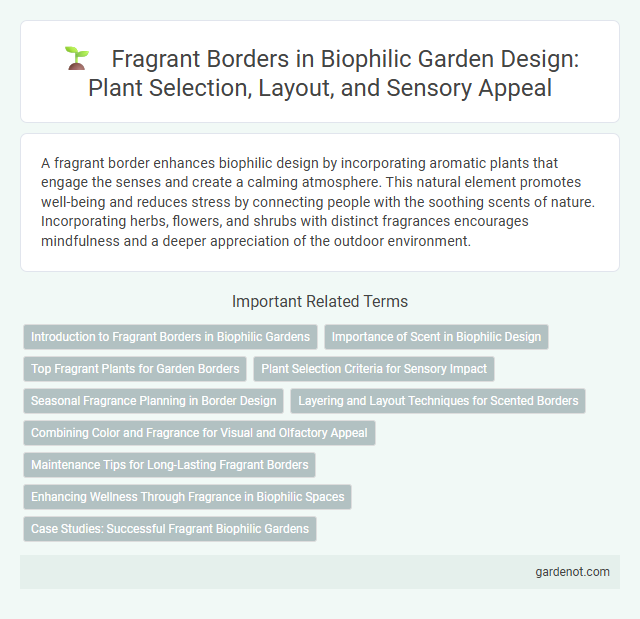A fragrant border enhances biophilic design by incorporating aromatic plants that engage the senses and create a calming atmosphere. This natural element promotes well-being and reduces stress by connecting people with the soothing scents of nature. Incorporating herbs, flowers, and shrubs with distinct fragrances encourages mindfulness and a deeper appreciation of the outdoor environment.
Introduction to Fragrant Borders in Biophilic Gardens
Fragrant borders in biophilic gardens integrate aromatic plants to enhance sensory experiences and create a calming environment. Combining herbs such as lavender, rosemary, and thyme maximizes olfactory stimulation while supporting pollinators and biodiversity. These aromatic plantings promote mental well-being by connecting individuals with nature through scent and color harmony.
Importance of Scent in Biophilic Design
Scent plays a crucial role in biophilic design by enhancing the connection between indoor environments and nature through fragrant borders. Incorporating aromatic plants such as lavender, rosemary, or jasmine in outdoor or indoor spaces stimulates sensory engagement, reduces stress, and improves mood and cognitive function. Fragrant borders not only provide olfactory pleasure but also promote well-being and a deeper sense of place within built environments.
Top Fragrant Plants for Garden Borders
Top fragrant plants for garden borders include lavender, rosemary, and jasmine, known for their strong, pleasant aromas that enhance outdoor spaces. Incorporating these plants in a biophilic design not only elevates sensory experience but also attracts pollinators like bees and butterflies, supporting biodiversity. Their perennial nature ensures lasting fragrance throughout seasons, making them ideal choices for sustainable garden borders.
Plant Selection Criteria for Sensory Impact
Plant selection criteria for fragrant borders prioritize species with strong, pleasant aromas that stimulate the olfactory senses and enhance outdoor spaces. Native herbs like lavender, rosemary, and thyme are ideal for their robust scents and environmental adaptability. Seasonal bloom cycles and scent intensity at different times of day also influence choices to maximize sensory impact throughout the year.
Seasonal Fragrance Planning in Border Design
Seasonal fragrance planning in border design enhances biophilic spaces by integrating plants that emit distinct scents throughout the year, such as lavender in summer and sweet alyssum in spring. Selecting species with staggered bloom times ensures continuous aromatic experiences, supporting wellbeing and connection to nature. This careful planning optimizes sensory engagement, creating dynamic, multisensory environments in alignment with biophilic design principles.
Layering and Layout Techniques for Scented Borders
Layering and layout techniques enhance the effectiveness of fragrant borders by combining plants with complementary scents, creating a multi-dimensional olfactory experience. Strategic placement of aromatic herbs, flowers, and shrubs in staggered heights and varying bloom times ensures continuous fragrance release throughout the seasons. Incorporating evergreen foliage alongside seasonal bloomers maintains consistent scent presence, promoting a soothing biophilic connection.
Combining Color and Fragrance for Visual and Olfactory Appeal
A fragrant border enhances biophilic design by strategically combining vibrant floral colors with complementary scents to create an immersive sensory experience. Selecting plants with diverse hues and natural fragrances, such as lavender, rosemary, and jasmine, attracts pollinators while promoting relaxation and well-being. This multisensory approach connects indoor and outdoor environments, boosting emotional benefits and aesthetic harmony.
Maintenance Tips for Long-Lasting Fragrant Borders
To ensure long-lasting fragrant borders, regularly prune plants like lavender, rosemary, and gardenia to encourage healthy growth and prevent overcrowding. Apply organic mulch to retain soil moisture and suppress weeds, promoting robust root development critical for sustained fragrance production. Water early in the morning to minimize evaporation and fungal diseases while using slow-release fertilizers rich in potassium to enhance flower and scent intensity.
Enhancing Wellness Through Fragrance in Biophilic Spaces
Fragrant borders integrate aromatic plants such as lavender, rosemary, and jasmine to stimulate senses and promote relaxation in biophilic spaces. Incorporating these natural scents enhances emotional well-being and reduces stress by triggering positive neurological responses. Strategic placement of fragrant borders maximizes air quality and creates a soothing environment that supports mental clarity and physiological health.
Case Studies: Successful Fragrant Biophilic Gardens
Successful fragrant biophilic gardens, such as the Brooklyn Botanic Garden's Fragrance Walk and Singapore's Gardens by the Bay, showcase how strategically planted aromatic borders enhance sensory engagement and emotional well-being. These case studies demonstrate the effective use of lavender, rosemary, jasmine, and other scented plants to create immersive, restorative environments that support mental health and biodiversity. Data from these projects reveal increased visitor satisfaction and extended dwell times, underscoring the positive impact of fragrant borders in urban green spaces.
Fragrant border Infographic

 gardenot.com
gardenot.com